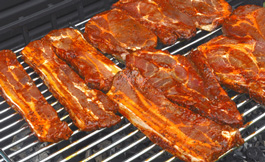
Hey guys,
I got some BBQ grease stains on some olefin carpet that need attention by one of my customers. I am thinking about using either the Pro Solve or Power Gel made by pros choice. What do you think?
Bill: Actually meat stains are more of a food (protein) stain and should come out with your prespray, Matrix Grand Slam and All Fiber Rinse extraction. If there is a residue left, then I would try Red Relief. Being olefin you aren’t going to hurt it. This was a way too easy question so let me wax nostalgic for a minute …
The only time I have been fooled with BBQ sauce was during a spotting class. I made up some stained carpets and used BBQ sauce from my refrigerator. No one in the class could get out the suspicious yellow stain that was left after spotting. It looked a lot like the mustard yellowing that is frequently left behind. We tried Stain Magic, heat, Red Relief and anything else we could find.
When I went home I looked at the ingredients on the BBQ sauce bottle. Sure enough it contained “turmeric”! Here is probably more information than you ever wanted to know about “turmeric” from Wikipedia. Note the frequent mentions of turmeric being used as a “food coloring agent”.
Steve: Uh-oh. When Big Billy says it is “probably more information than you ever wanted to know” ya better batten down the hatches!
Turmeric grows wild in the forests of Southeast Asia. It has become the key ingredient for many Indian, Persian, Thai and Malay dishes, not only in curry, but also in masak lemak, rendang and many more.
In Indonesia, the turmeric leaves are used for Minangese or Padangese curry base of Sumatra such as rendang, sate padang and many other varieties.
Although most usage of turmeric is in the form of root powder, in some regions (especially in Maharashtra), leaves of turmeric are used to wrap and cook food. This usually takes place in areas where turmeric is grown locally, since the leaves used are freshly picked. This imparts a distinct flavor.
In non-South Asian recipes, turmeric is sometimes used as an agent to impart a rich, custard-like yellow color. It is used in canned beverages and baked products, dairy products, ice cream, yogurt, yellow cakes, orange juice, biscuits, popcorn color, sweets, cake icings, cereals, sauces, gelatins, etc. It is a significant ingredient in most commercial curry powders. Turmeric is mostly used in savory dishes, as well as some sweet dishes such as the cake Sfouf.
Although usually used in its dried, powdered form, turmeric is also used fresh, much like ginger. It has numerous uses in Far Eastern recipes, such as fresh turmeric pickle which contains large chunks of soft turmeric.
Turmeric (coded as E100 when used as a food additive) is used to protect food products from sunlight. The oleoresin is used for oil-containing products. The curcumin/polysorbate solution or curcumin powder dissolved in alcohol is used for water-containing products. Over-coloring, such as in pickles, relishes, and mustard, is sometimes used to compensate for fading.
In combination with annatto (E160b), turmeric has been used to color cheeses, yogurt, dry mixes, salad dressings, winter butter and margarine. Turmeric is also used to give a yellow color to some prepared mustards, canned chicken broths and other foods (often as a much cheaper replacement for saffron).
Turmeric is widely used as a spice in South Asian and Middle Eastern cooking. Many Persian dishes use Turmeric, for the coloring of rice bottoms as well as a starter ingredient for almost all Iranian fry ups (which typically consist of oil, onions and turmeric followed by any other ingredients that are to be included). In Nepal, turmeric is widely grown and is extensively used in almost every vegetable and meat dish in the country for its color as well as for its medicinal value. In South Africa turmeric is traditionally used to give boiled white rice a golden color.
Quoted from Wikipedia
Steve: You are right Bill. That is waaaaay more information than anyone really wanted to know. What … is Papa Nick paying you by the word now? This cut-and-paste stuff can easily get out of hand! (Plus it is cheating!)
Bill: Here is one other helpful bit of information. You may have seen turmeric stains turn red when treating them. Why you ask? Or maybe you don’t really care but I am on a roll so I’m going to tell you any way …
Turmeric contains up to 5% essential oils and up to 5% curcumin, a polyphenol. It is the active substance of turmeric and it is also known as C.I. 75300, or Natural Yellow 3. The systematic chemical name is (1E,6E)-1,7-bis(4-hydroxy-3-methoxyphenyl)-1,6-heptadiene-3,5-dione.
It can exist at least in two tautomeric forms, keto and enol. The keto form is preferred in solid phase and the enol form in solution.
Curcumin is a pH indicator. In acidic solutions (as in below 7.4 pH) it turns yellow whereas in basic pH (over 8.6 pH) solutions it turns bright red.
Quoted from Wikipedia
So who needs pH paper any more! Just visit any Indian restaurant instead!
Steve: Now you are talking! I’m up for a bit of “field testing” any time when it involves ethnic foods!



